Abstract
The role of prostaglandins in the regulation of muscle protein breakdown is controversial. We examined the influence of arachidonic acid (5 microM), prostaglandin E2 (PGE2) (2.8 microM) and the prostaglandin-synthesis inhibitor indomethacin (3 microM) on total and myofibrillar protein breakdown in rat extensor digitorum longus and soleus muscles incubated under different conditions in vitro. In other experiments, the effects of indomethacin, administered in vivo to septic rats (3 mg/kg, injected subcutaneously twice after induction of sepsis by caecal ligation and puncture) on plasma levels and muscle release of PGE2 and on total and myofibrillar protein breakdown rates were determined. Total and myofibrillar proteolysis was assessed by measuring production by incubated muscles of tyrosine and 3-methylhistidine respectively. Arachidonic acid or PGE2 added during incubation of muscles from normal rats did not affect total or myofibrillar protein degradation under a variety of different conditions in vitro. Indomethacin inhibited muscle PGE2 production by incubated muscles from septic rats, but did not lower proteolytic rates. Administration in vivo of indomethacin did not affect total or myofibrillar muscle protein breakdown, despite effective plasma levels of indomethacin with decreased plasma PGE2 levels and inhibition of muscle PGE2 release. The present results suggest that protein breakdown in skeletal muscle of normal or septic rats is not regulated by PGE2 or other prostaglandins.
Full text
PDF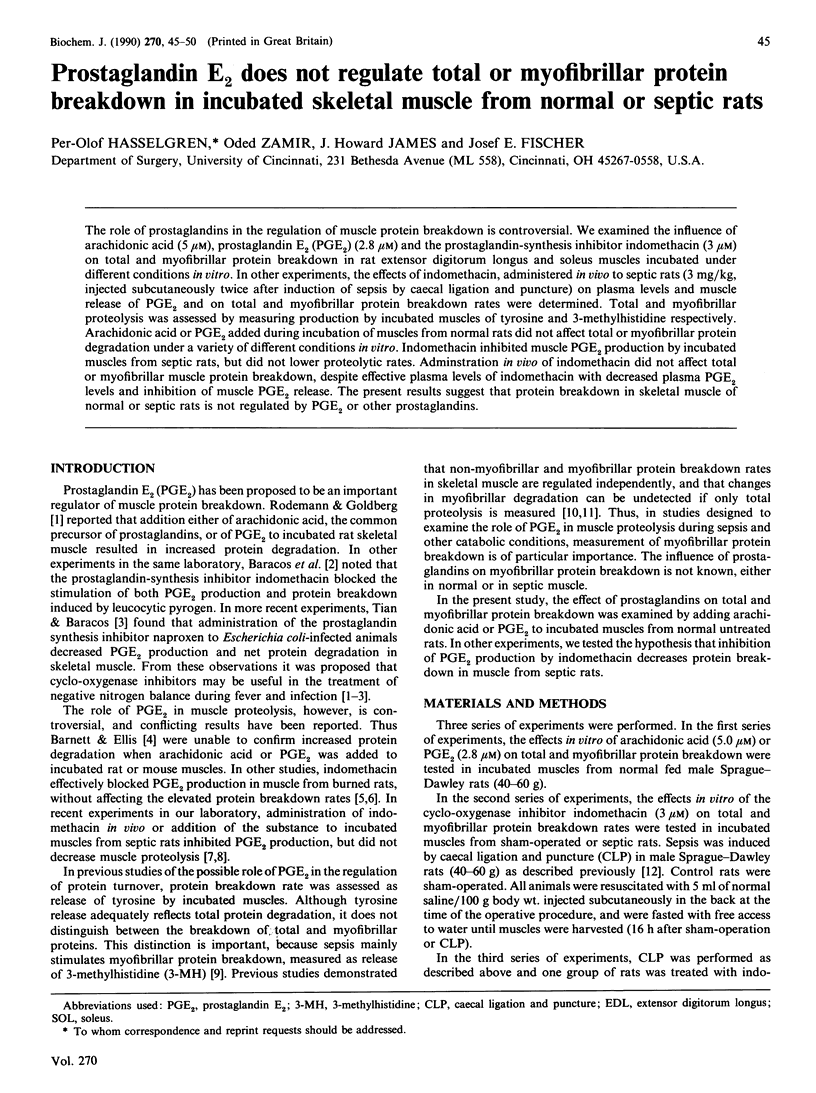
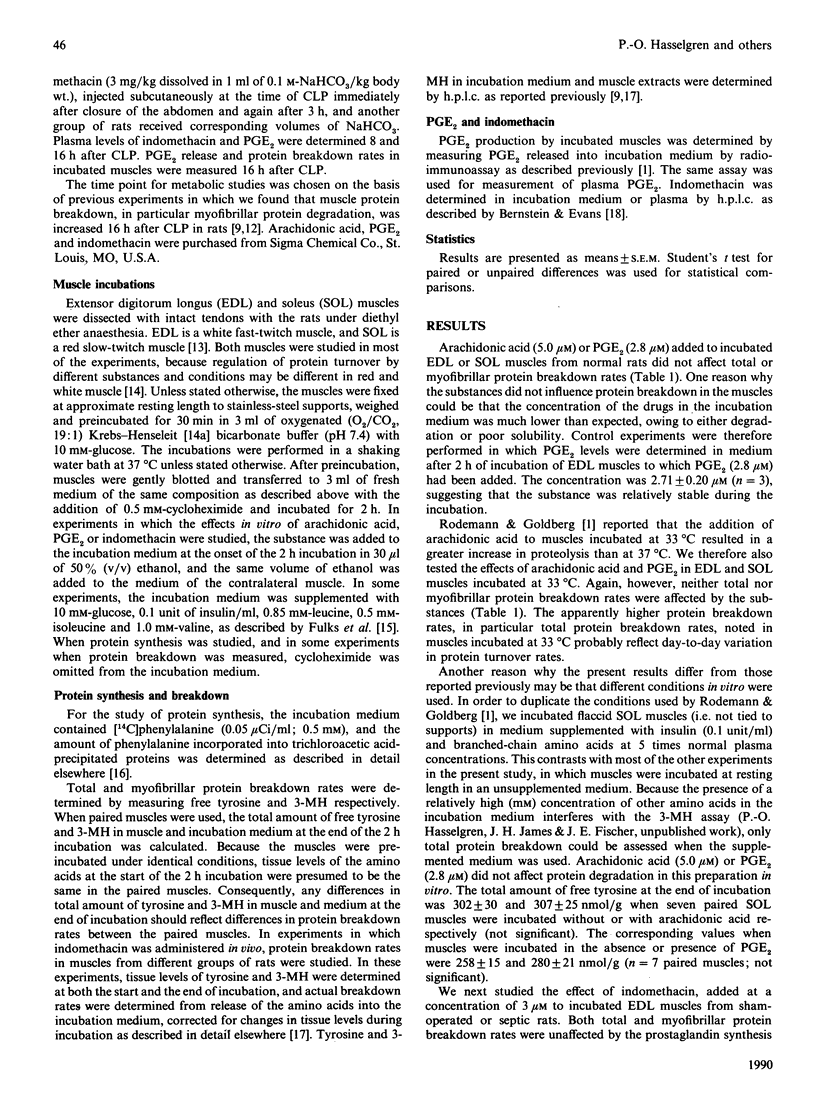

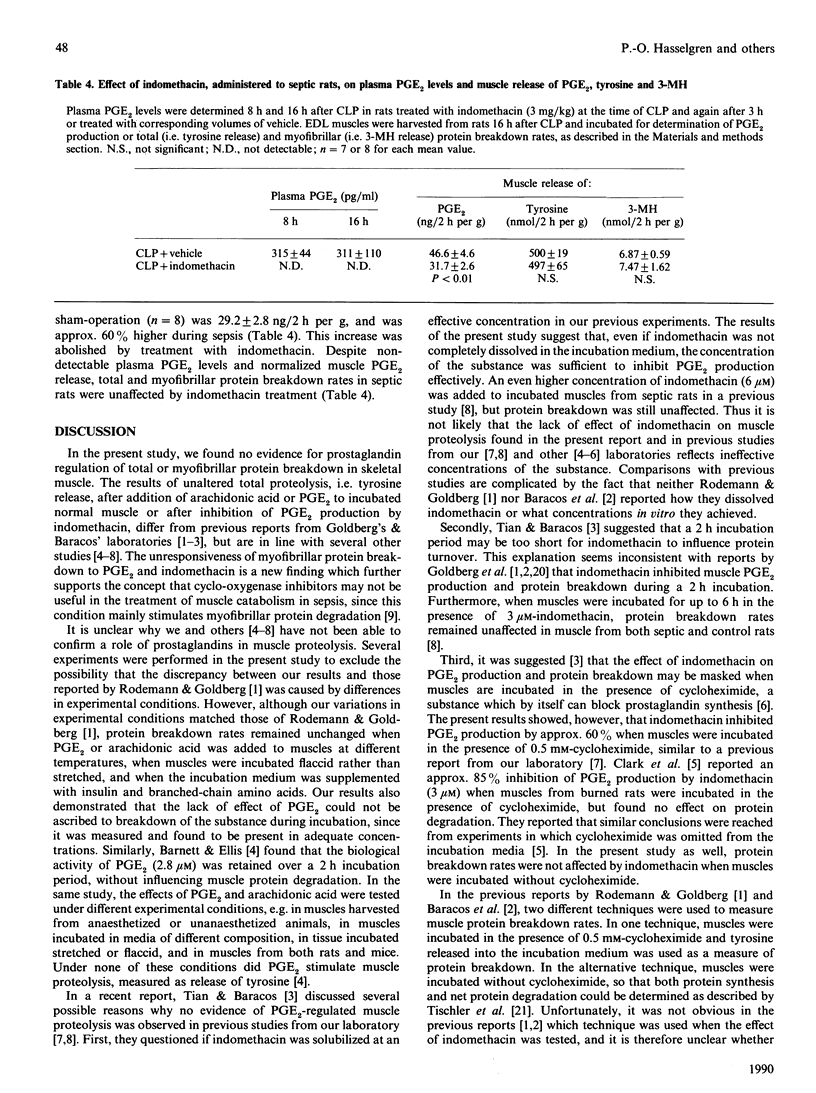
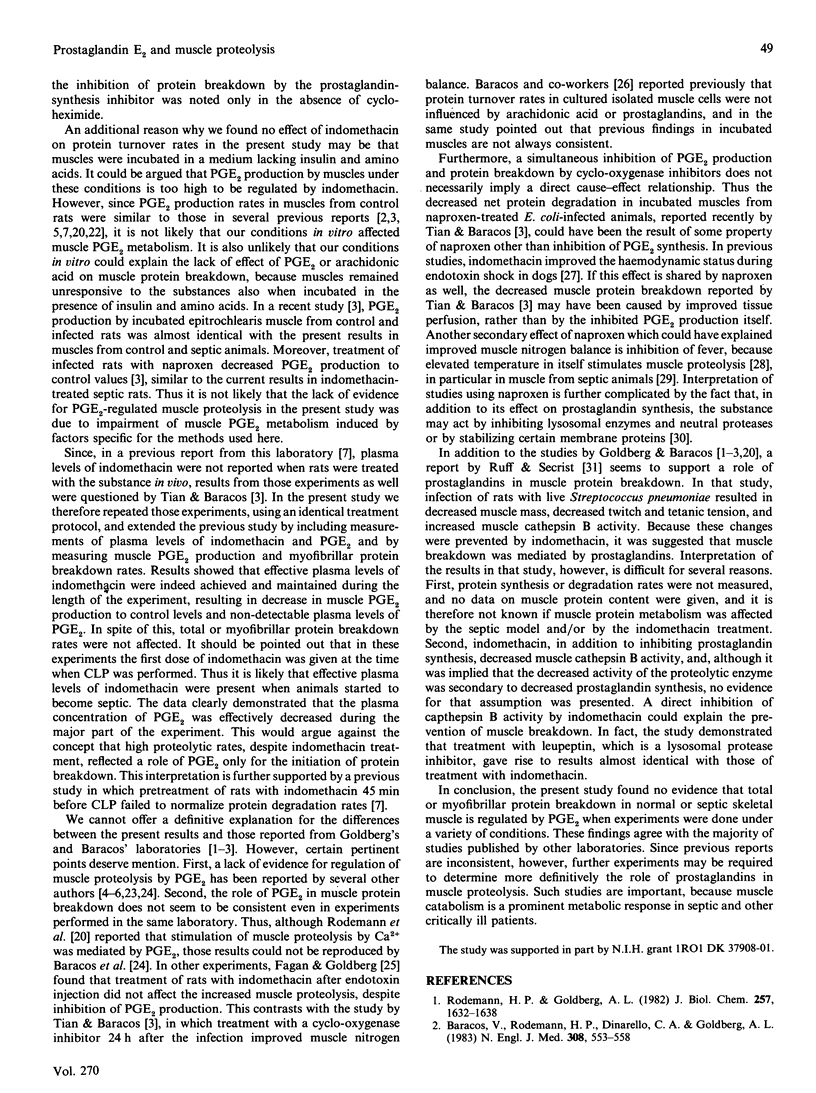
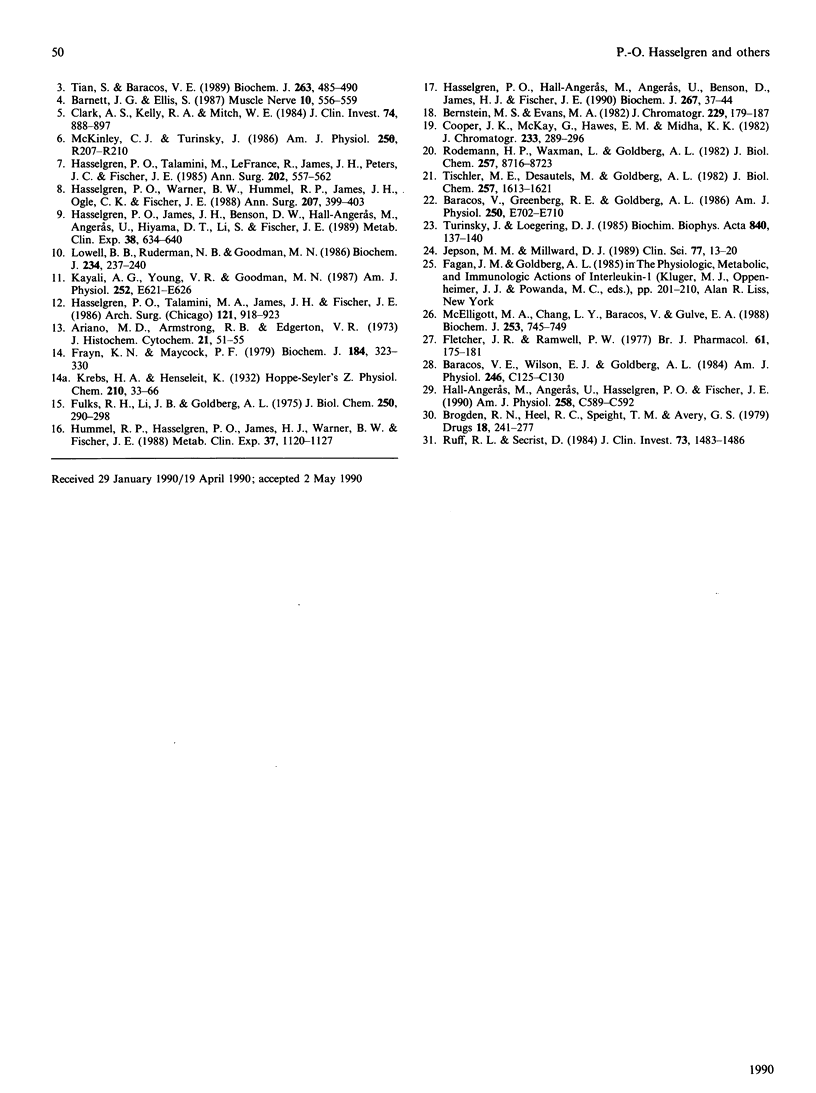
Selected References
These references are in PubMed. This may not be the complete list of references from this article.
- Ariano M. A., Armstrong R. B., Edgerton V. R. Hindlimb muscle fiber populations of five mammals. J Histochem Cytochem. 1973 Jan;21(1):51–55. doi: 10.1177/21.1.51. [DOI] [PubMed] [Google Scholar]
- Baracos V. E., Wilson E. J., Goldberg A. L. Effects of temperature on protein turnover in isolated rat skeletal muscle. Am J Physiol. 1984 Jan;246(1 Pt 1):C125–C130. doi: 10.1152/ajpcell.1984.246.1.C125. [DOI] [PubMed] [Google Scholar]
- Baracos V., Greenberg R. E., Goldberg A. L. Influence of calcium and other divalent cations on protein turnover in rat skeletal muscle. Am J Physiol. 1986 Jun;250(6 Pt 1):E702–E710. doi: 10.1152/ajpendo.1986.250.6.E702. [DOI] [PubMed] [Google Scholar]
- Baracos V., Rodemann H. P., Dinarello C. A., Goldberg A. L. Stimulation of muscle protein degradation and prostaglandin E2 release by leukocytic pyrogen (interleukin-1). A mechanism for the increased degradation of muscle proteins during fever. N Engl J Med. 1983 Mar 10;308(10):553–558. doi: 10.1056/NEJM198303103081002. [DOI] [PubMed] [Google Scholar]
- Barnett J. G., Ellis S. Prostaglandin E2 and the regulation of protein degradation in skeletal muscle. Muscle Nerve. 1987 Jul-Aug;10(6):556–559. doi: 10.1002/mus.880100611. [DOI] [PubMed] [Google Scholar]
- Bernstein M. S., Evans M. A. High-performance liquid chromatography-fluorescence analysis for indomethacin and metabolites in biological fluids. J Chromatogr. 1982 Apr 16;229(1):179–187. doi: 10.1016/s0378-4347(00)86049-1. [DOI] [PubMed] [Google Scholar]
- Brogden R. N., Heel R. C., Speight T. M., Avery G. S. Naproxen up to date: a review of its pharmacological properties and therapeutic efficacy and use in rheumatic diseases and pain states. Drugs. 1979 Oct;18(4):241–277. doi: 10.2165/00003495-197918040-00001. [DOI] [PubMed] [Google Scholar]
- Clark A. S., Kelly R. A., Mitch W. E. Systemic response to thermal injury in rats. Accelerated protein degradation and altered glucose utilization in muscle. J Clin Invest. 1984 Sep;74(3):888–897. doi: 10.1172/JCI111506. [DOI] [PMC free article] [PubMed] [Google Scholar]
- Cooper J. K., McKay G., Hawes E. M., Midha K. K. High-performance liquid chromatographic assay of indomethacin and its application in pharmacokinetics in healthy volunteers. J Chromatogr. 1982 Dec 10;233:289–296. doi: 10.1016/s0378-4347(00)81755-7. [DOI] [PubMed] [Google Scholar]
- Fletcher J. R., Ramwell P. W. Modification, by aspirin and indomethacin, of the haemodynamic and prostaglandin releasing effects of E. coli endotoxin in the dog. Br J Pharmacol. 1977 Oct;61(2):175–181. doi: 10.1111/j.1476-5381.1977.tb08402.x. [DOI] [PMC free article] [PubMed] [Google Scholar]
- Frayn K. N., Maycock P. F. Regulation of protein metabolism by a physiological concentration of insulin in mouse soleus and extensor digitorum longus muscles. Effects of starvation and scald injury. Biochem J. 1979 Nov 15;184(2):323–330. doi: 10.1042/bj1840323. [DOI] [PMC free article] [PubMed] [Google Scholar]
- Fulks R. M., Li J. B., Goldberg A. L. Effects of insulin, glucose, and amino acids on protein turnover in rat diaphragm. J Biol Chem. 1975 Jan 10;250(1):290–298. [PubMed] [Google Scholar]
- Hall-Angerås M., Angerås U., Hasselgren P. O., Fischer J. E. Effects of elevated temperature on protein breakdown in muscles from septic rats. Am J Physiol. 1990 Apr;258(4 Pt 1):C589–C592. doi: 10.1152/ajpcell.1990.258.4.C589. [DOI] [PubMed] [Google Scholar]
- Hasselgren P. O., Hall-Angerås M., Angerås U., Benson D., James J. H., Fischer J. E. Regulation of total and myofibrillar protein breakdown in rat extensor digitorum longus and soleus muscle incubated flaccid or at resting length. Biochem J. 1990 Apr 1;267(1):37–44. doi: 10.1042/bj2670037. [DOI] [PMC free article] [PubMed] [Google Scholar]
- Hasselgren P. O., James J. H., Benson D. W., Hall-Angerås M., Angerås U., Hiyama D. T., Li S., Fischer J. E. Total and myofibrillar protein breakdown in different types of rat skeletal muscle: effects of sepsis and regulation by insulin. Metabolism. 1989 Jul;38(7):634–640. doi: 10.1016/0026-0495(89)90100-5. [DOI] [PubMed] [Google Scholar]
- Hasselgren P. O., Talamini M., James J. H., Fischer J. E. Protein metabolism in different types of skeletal muscle during early and late sepsis in rats. Arch Surg. 1986 Aug;121(8):918–923. doi: 10.1001/archsurg.1986.01400080064011. [DOI] [PubMed] [Google Scholar]
- Hasselgren P. O., Talamini M., LaFrance R., James J. H., Peters J. C., Fischer J. E. Effect of indomethacin on proteolysis in septic muscle. Ann Surg. 1985 Nov;202(5):557–562. doi: 10.1097/00000658-198511000-00004. [DOI] [PMC free article] [PubMed] [Google Scholar]
- Hasselgren P. O., Warner B. W., Hummel R. P., 3rd, James J. H., Ogle C. K., Fischer J. E. Further evidence that accelerated muscle protein breakdown during sepsis is not mediated by prostaglandin E2. Ann Surg. 1988 Apr;207(4):399–403. doi: 10.1097/00000658-198804000-00005. [DOI] [PMC free article] [PubMed] [Google Scholar]
- Hummel R. P., 3rd, Hasselgren P. O., James J. H., Warner B. W., Fischer J. E. The effect of sepsis in rats on skeletal muscle protein synthesis in vivo and in periphery and central core of incubated muscle preparations in vitro. Metabolism. 1988 Dec;37(12):1120–1127. doi: 10.1016/0026-0495(88)90187-4. [DOI] [PubMed] [Google Scholar]
- Jepson M. M., Millward D. J. Effect of the cyclo-oxygenase inhibitor fenbufen on muscle and liver protein metabolism, muscle glutamine and plasma insulin in endotoxaemic rats. Clin Sci (Lond) 1989 Jul;77(1):13–20. doi: 10.1042/cs0770013. [DOI] [PubMed] [Google Scholar]
- Kayali A. G., Young V. R., Goodman M. N. Sensitivity of myofibrillar proteins to glucocorticoid-induced muscle proteolysis. Am J Physiol. 1987 May;252(5 Pt 1):E621–E626. doi: 10.1152/ajpendo.1987.252.5.E621. [DOI] [PubMed] [Google Scholar]
- Lowell B. B., Ruderman N. B., Goodman M. N. Evidence that lysosomes are not involved in the degradation of myofibrillar proteins in rat skeletal muscle. Biochem J. 1986 Feb 15;234(1):237–240. doi: 10.1042/bj2340237. [DOI] [PMC free article] [PubMed] [Google Scholar]
- McElligott M. A., Chaung L. Y., Baracos V., Gulve E. A. Prostaglandin production in myotube cultures. Influence on protein turnover. Biochem J. 1988 Aug 1;253(3):745–749. doi: 10.1042/bj2530745. [DOI] [PMC free article] [PubMed] [Google Scholar]
- McKinley C. J., Turinsky J. Prostaglandin E2 and muscle proteolysis: effect of burn injury and cycloheximide. Am J Physiol. 1986 Feb;250(2 Pt 2):R207–R210. doi: 10.1152/ajpregu.1986.250.2.R207. [DOI] [PubMed] [Google Scholar]
- Rodemann H. P., Goldberg A. L. Arachidonic acid, prostaglandin E2 and F2 alpha influence rates of protein turnover in skeletal and cardiac muscle. J Biol Chem. 1982 Feb 25;257(4):1632–1638. [PubMed] [Google Scholar]
- Rodemann H. P., Waxman L., Goldberg A. L. The stimulation of protein degradation in muscle by Ca2+ is mediated by prostaglandin E2 and does not require the calcium-activated protease. J Biol Chem. 1982 Aug 10;257(15):8716–8723. [PubMed] [Google Scholar]
- Ruff R. L., Secrist D. Inhibitors of prostaglandin synthesis or cathepsin B prevent muscle wasting due to sepsis in the rat. J Clin Invest. 1984 May;73(5):1483–1486. doi: 10.1172/JCI111352. [DOI] [PMC free article] [PubMed] [Google Scholar]
- Tian S., Baracos V. E. Prostaglandin-dependent muscle wasting during infection in the broiler chick (Gallus domesticus) and the laboratory rat (Rattus norvegicus). Biochem J. 1989 Oct 15;263(2):485–490. doi: 10.1042/bj2630485. [DOI] [PMC free article] [PubMed] [Google Scholar]
- Tischler M. E., Desautels M., Goldberg A. L. Does leucine, leucyl-tRNA, or some metabolite of leucine regulate protein synthesis and degradation in skeletal and cardiac muscle? J Biol Chem. 1982 Feb 25;257(4):1613–1621. [PubMed] [Google Scholar]
- Turinsky J., Loegering D. J. Prostaglandin E2 and muscle protein turnover in Pseudomonas aeruginosa sepsis. Biochim Biophys Acta. 1985 May 29;840(1):137–140. doi: 10.1016/0304-4165(85)90171-0. [DOI] [PubMed] [Google Scholar]


